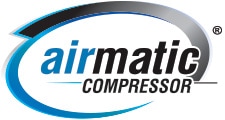David Van’t Slot, System Specialist
Many customers ask: How does a refrigerated dryer work and how do you properly size one for my compressed air system? The easiest explanation for how it works is this: Similar to dew collected on the lawn on a cool morning, when compressed air is chilled, usually to 38 degrees F, suspended water drops out of the air and changes to liquid water (condensate). The condensate collects in a moisture separator, once enough water collects the electronic drain valve will blow condensate into an Oil Water Separator for proper disposal.
The compressed air then will have a pressure dew point similar to the temperature that the air was chilled to. I have also explained it in this way: You know when you leave a 6 pack of beer in the car on a 100 Degree day, it takes longer to cool in the refrigerator than beer that starts at 70 degrees. It’s the same concept. The customer typically smiles and nods, but understands how initial temperature can affect how quickly something is cooled to the desired temperature. (or maybe they are smiling because they are thinking about the weekend).
Compressed air dryers are rated to achieve a specified pressure dew-point or moisture level (usually. 38°F pressure dew point) for a certain volume of air flow (cfm). This flow rating is based on “standard conditions” (100 psig, 100° F inlet temperature, and 100° F ambient temperature). Your actual conditions will change from day to day.
It is important to understand how pressure and temperature affect water content in compressed air, when sizing a dryer. The suspended water vapor content of air changes directly with temperature—if temperature increases, the air’s ability to suspend water increases. The hotter the air entering the dryer, it will take a larger refrigeration system to bring the air to the proper temperature/dew point.
Water vapor content of air changes inversely with pressure—if pressure increases, it squeezes moisture out. Because of these physical relationships, compressed air dryers need correction factors to determine how much air a particular dryer can actually handle at specific conditions. (see correction factor chart below).
While selecting points on the correction factor, make sure you go with the worst-case scenario using the conditions during the hotter and humid summer season. The chart below shows how a dryer will be more or less efficient depending on how the conditions vary. This is a great tool while sizing a dryer for your particular conditions.
Rules of Thumb:
• The higher pressure above 100 PSI—–dryer will be more efficient
• The lower temperature of the room and the compressed air that enters—-the dryer will be more efficient.
• The lower pressure below 100 PSI——dryer will be less efficient
• The higher temperature of the room and the compressed air that enters—-the dryer will be less efficient.
Using the Correction Factor Chart. Proposed Conditions for a 100 CFM DRYER Selection: 130Psi Compressed Air–100 Degree F ambient room temperature–115 Degree F approach (temperature of compressed air as it enters the dryer)
Calculation:
DRYER CFM (100) X PSI Correction factor at 130 Psi (1.09) X Ambient Temperature correction factor at 100 degree f (1) x Approach Temperature correction factor at 115 degree f( .71)= The overall correction factor to the dryer that you are selecting (77.39 CFM) to attain a 38 degree dew point at these conditions.
This is for basic sizing only, please contact your compressed air professional for further assistance.
